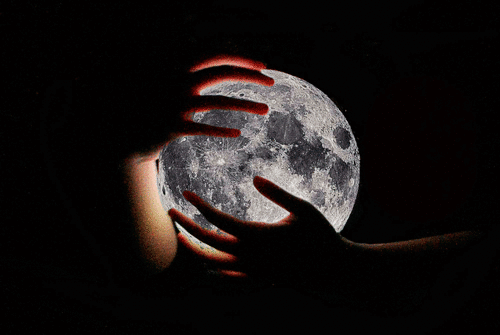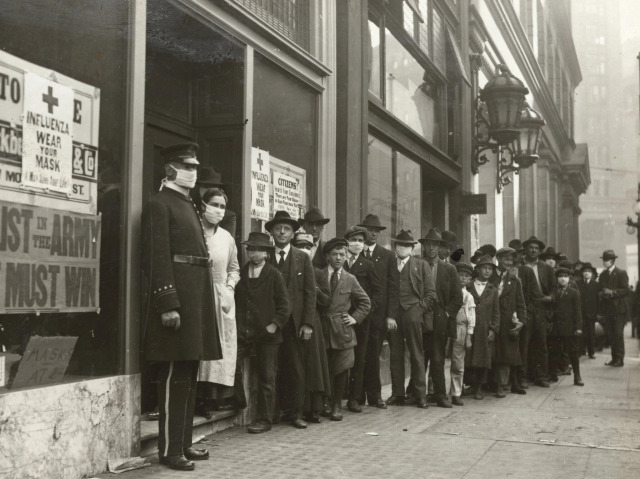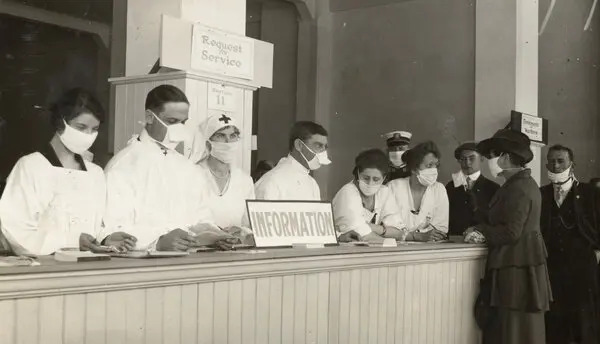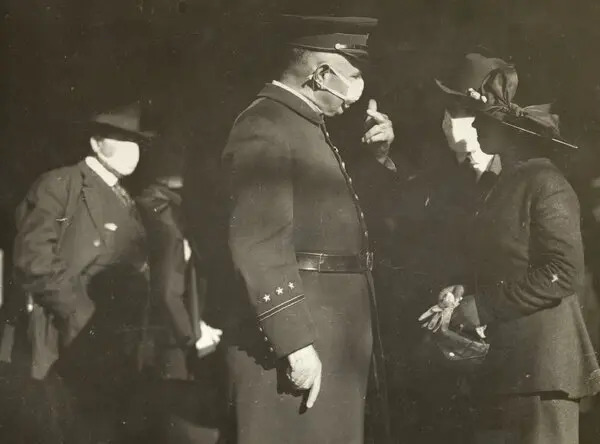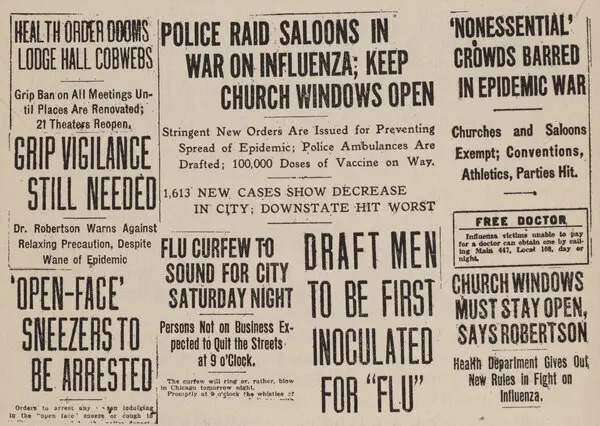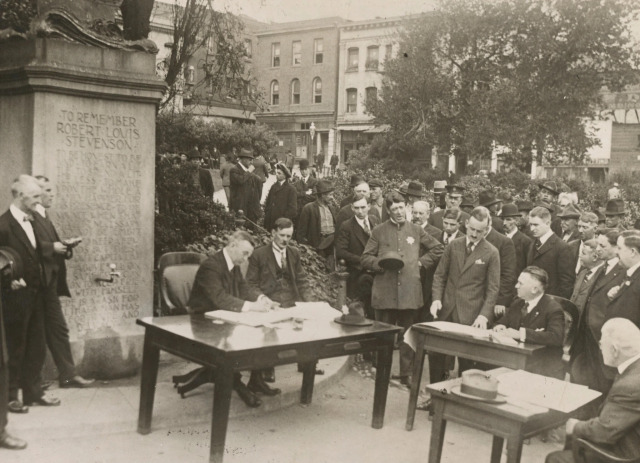The Mask Slackers of 1918
As the influenza pandemic swept across the United States in 1918 and 1919, masks took a role in political and cultural wars.
By Christine Hauser - Aug. 3, 2020
The masks were called muzzles, germ shields and dirt traps. They gave people a “pig-like snout.” Some people
snipped holes in their masks to smoke cigars. Others fastened them to dogs in mockery. Bandits used them to rob banks.
More than a century ago, as the 1918 influenza pandemic raged in the United States, masks of gauze and cheesecloth became the facial front lines in the battle against the virus. But as they have now, the masks also stoked political division. Then, as now, medical authorities urged the wearing of masks to help slow the spread of disease. And then, as now, some people resisted.
In 1918 and 1919, as bars, saloons, restaurants, theaters and schools were closed, masks became a scapegoat, a symbol of government overreach, inspiring protests, petitions and defiant bare-face gatherings. All the while, thousands of Americans were dying in a deadly pandemic.
1918: The infection spreads.
The first infections were identified in March, at an Army base in Kansas, where 100 soldiers were infected. Within a week, the number of flu cases grew fivefold,
and soon the disease was taking hold across the country, prompting some cities to impose quarantines and mask orders to contain it.
By the fall of 1918, seven cities — San Francisco, Seattle, Oakland, Sacramento, Denver, Indianapolis and Pasadena, Calif. — had put in effect mandatory face mask laws, said Dr. Howard Markel, a historian of epidemics and the author of “Quarantine!”
Organized
resistance to mask wearing was not common, Dr. Markel said, but it was present. “There were flare-ups, there were scuffles and there were
occasional groups, like the Anti-Mask League,” he said, “but that is the exception rather than the rule.
By
the end of October, there were more than 60,000 cases statewide, with
7,000 of them in San Francisco. It soon became known as the “masked
city.”
Workers at an information desk wearing masks in San Francisco in 1918
“The Mask Ordinance,” signed by Mayor James Rolph on Oct. 22, made San
Francisco the first American city to require face coverings, which had
to be four layers thick.
Masks that looked like ‘slabs of ravioli’
Alma Whitaker, writing in The Los Angeles Times on Oct. 22, 1918, reviewed masks’ impact on society and celebrity, saying famous people shunned them because it was “so horrid” to go unrecognized.
“The big restaurants are the funniest sights, with all the waiters and diners masked, the latter just raising their screen to pop in a mouthful of food,” she wrote.
When Ms.
Whitaker herself declined to wear one, she was “forcibly taken” to the
Red Cross as a “slacker,” and ordered to make one and put it on.
A policeman wearing a flu mask talking to a couple, one masked, one not
The San Francisco Chronicle said the simplest type of mask was of folded
gauze affixed with elastic or tape. The police went for gauze masks,
which resembled an unflattering “nine ordinary slabs of ravioli arranged
in a square.”
There was room
for creativity. Some of the coverings were “fearsome looking machines”
that lent a “pig-like aspect” to the wearer’s face.
A man is refused access to a streetcar in 1918 Seattle,
because he is not wearing a face mask
Mask court
The penalty for violators was $5 to $10, or 10 days’ imprisonment.
On Nov. 9, 1,000 people were arrested, The San Francisco Chronicle reported. City prisons swelled to standing room only; police shifts and court sessions were added to help manage.
“Where is your mask?” Judge Mathew Brady asked offenders at the Hall of Justice, where sessions dragged into night. Some gave fake names, said they just wanted to light a cigar or that they hated following laws.
Jail terms of 8 hours to 10 days were given out. Those who could not pay $5 were jailed for 48 hours.
Rail commuters wearing white protective masks, one with the additional message
“wear a mask or go to jail,” during the 1918 influenza pandemic in California.
The ‘mask slacker’ of San Francisco is shot.
On Oct. 28, a blacksmith named James Wisser stood on Powell and Market streets in front of a drugstore, urging a crowd to dispose of their masks, which he described as “bunk.”
A health inspector, Henry D. Miller, led him to the drugstore to buy a mask.
At the door, Mr. Wisser struck Mr. Miller with a sack of silver dollars and knocked him to the ground, The San Francisco Chronicle reported. While being “pummeled,” Mr. Miller, 62, fired four times with a revolver. Passers-by “scurried for cover,” The Associated Press said.
Mr. Wisser was injured, as were two bystanders. He was charged with disturbing the peace, resisting an officer and assault. The inspector was charged with assault with a deadly weapon.
In Los Angeles, ‘To Mask or Not to Mask.’
That
was the headline for a report published in The Los Angeles Times when
city officials met in November to decide whether to require residents to
wear “germ scarers” or “flu-scarers.”
Public
feedback was invited. Some supported masks so theaters, churches and
schools could operate. Opponents said masks were “mere dirt and dust
traps and do more harm than good.”
“I have seen some persons wearing their masks for a while hanging about their necks, and then apply them to their faces, forgetting that they might have picked up germs while dangling about their clothes,” Dr. E.W. Fleming said in a Los Angeles Times report.
An ear, nose and throat specialist, Dr. John J. Kyle, said: “I saw a woman in a restaurant today with a mask on. She was in ordinary street clothes, and every now and then she raised her hand to her face and fussed with the mask.”
In Illinois, the right to choose, and to reject.
Suffragists
fighting for the right to vote made a gesture that rejected covering
their mouths at a time when their voices were crucial.
At
the annual convention of the Illinois Equal Suffrage Association, in
October 1918, they set chairs four feet apart, closed doors to the
public and limited attendance to 100 delegates, the Chicago Daily
Tribune reported.
Headlines from newspapers in Chicago
But the women “showed their scorn” for masks, it said. It’s unclear why.
Allison
K. Lange, an associate history professor at Wentworth Institute of
Technology, said one reason could have been that they wanted to keep a
highly visible profile.
“Suffragists wanted to make sure their leaders were familiar political figures,” Dr. Lange said.
‘Four weeks of muzzled misery’
San Francisco’s mask ordinance expired after four weeks at noon on Nov. 21. The city celebrated, and church bells tolled.
A
“delinquent” bent on blowing his nose tore his mask off so quickly that
it “nearly ruptured his ear,” The San Francisco Chronicle reported. He
and others stomped on their masks in the street. As a police officer
watched, it dawned on him that “his vigil over the masks was done.”
Waiters,
barkeeps and others bared their faces. Drinks were on the house. Ice
cream shops handed out treats. The sidewalks were strewn with gauze, the
“relics of a torturous month,” The Chronicle said.
The spread had been halted. But a second wave was on the horizon.
By December, the San Francisco Board of Supervisors was again proposing a mask requirement, meeting with testy opposition.
Police Court Officials of San Francisco
Holding a session in the open, as a precaution against the spreading influenza epidemic in late November of 1918.
Around the end
of the year, a bomb was defused outside the office of San Francisco’s
chief health officer, Dr. William C. Hassler. “Things were violent and
aggressive, but it was because people were losing money,” said Brian
Dolan, a medical historian at the University of California, San
Francisco. “It wasn’t about a constitutional issue; it was a money
issue.”
By the end of 1918, the death
toll from influenza had reached at least 244,681, mostly in the last
four months, according to government statistics.
1919: A new year
In
January, Pasadena’s city commission passed a mask ordinance. The police grudgingly enforced it, cracking down on cigar smokers and passengers in cars. Sixty people were arrested on the first day, The Los Angeles Times reported on Jan. 22, in an article titled “Pasadena Snorts Under Masks.”
“It is the most unpopular law
ever placed on the Pasadena records,” W.S. McIntyre, the chief of
police, told the paper. “We are cursed from all sides.”
Some mocked the rule by stretching gauze across car vents or dog snouts. Cigar vendors said they lost customers, though enterprising aficionados cut a hole in the cloth. (They were still arrested.) Barbers lost shaving business. Merchants complained traffic dropped as more people stayed home.
Petitions were circulated at cigar stands. Arrests rose, even of the powerful. Ernest May, the president of Security National Bank of Pasadena, and five “prominent” guests were rounded up at the Maryland Hotel one Sunday.
They had masks on, but not covering their faces.
The Anti-Mask League.
That board’s decision led to the creation of the Anti-Mask League, a sign that resistance to masks was resurfacing as cities tried to reimpose orders to wear them when infections returned.
The league was led by a woman, E.J. Harrington, a lawyer, social activist and political opponent of the mayor. About a half-dozen other women filled its top ranks. Eight men also joined, some of them representing unions, along with two members of the board of supervisors who had voted against masks.
“The masks turned into a political symbol,” Dr. Dolan said.
A call to protest by the Anti-Mask League in The San Francisco Chronicle, on Jan. 25, 1919.
On Jan. 25, the league held its first organizational meeting, open to the public at the Dreamland Rink, where they united behind demands for the repeal of the mask ordinance and for the resignations of the mayor and health officials.
Their objections
included lack of scientific evidence that masks worked and the idea that forcing people to wear the coverings was unconstitutional.
On Jan. 27, the league protested at a Board of Supervisors meeting, but the mayor held his ground.
There were hisses and cries of “freedom and liberty,”
Dr. Dolan wrote in his paper on the epidemic.
Repeal came a few days later on Feb. 1, when Mayor Rolph cited a downturn in infections.
But a third wave of flu rolled in late that year. The final death toll reached an estimated 675,000 nationwide, or 30 for every 1,000 people in San Francisco, making it one of the worst-hit cities in America.
Dr. Dolan said the story of the Anti-Mask League, which has drawn renewed interest now in 2020, demonstrates the disconnect between individual choice and universal compliance.
That sentiment echoes through the century from the voice of a San Francisco railway worker named Frank Cocciniglia.
Arrested on Kearny Street in January, Mr. Cocciniglia told the judge that he “was not disposed to do anything not in harmony with his feelings,” according to a Los Angeles Times report.
He was sentenced to five days in jail.
“That suits me,” Mr. Cocciniglia said as he left the stand. “I won’t have to wear a mask there.”
Alain Delaqueriere contributed research.


 Those who do not learn from history
Are doomed to repeat it.
Those who do not learn from history
Are doomed to repeat it.
👇 📚 👇
Christine Hauser is a reporter, covering national and foreign news. Her previous jobs in the newsroom include stints in Business covering financial markets and on the Metro Desk in the police bureau. @ChristineNYT








